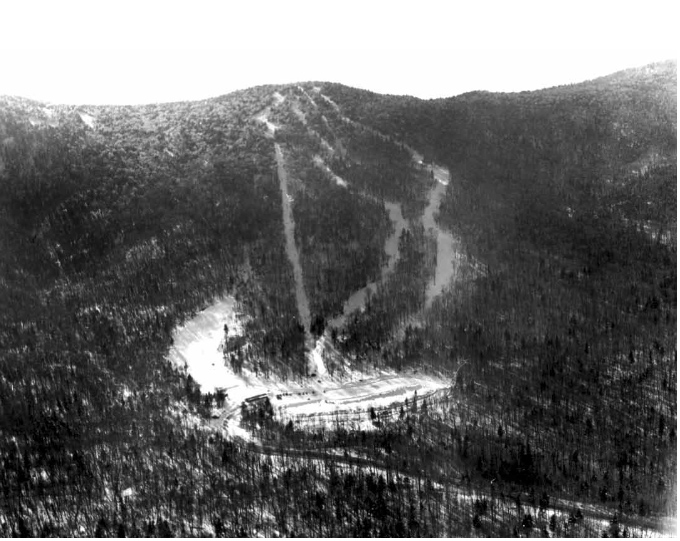By Karen D. Lorentz
Editors’ Note: This is part of a series on the factors that enabled Killington to become The Beast of the East. Quotations are from author interviews in the 1980s for the book “Killington, A Story of Mountains and Men.”
Despite the two-year delay to Killington’s debut—caused by the access road not being built—early investor and co-founder Wally Morrison remembered only one time when he and Joe Sargent were worried simultaneously.
“We were both discouraged; the road delay really bothered Joe. We’d come up to meet with Pres [Smith] and wondering how we were going to tell him that it was all over, was a painful part of that trip,” he said. Asked if he ever considered quitting, Smith said, “Sue once said, ‘You’ve got to give this thing up.’ But most of the time, she didn’t feel that way, and I never considered giving up.”
“It was a difficult and discouraging process at times,” Smith conceded, but he quickly added, “There was also a total commitment, and I never doubted it would work. Joe and Wally were enthusiastic, also, and besides supplying money, they wanted to help, not just be passive investors.”
Additionally, Smith noted that the 1957 Legislature mandated the building of the road, so he “knew it would eventually get built.” Patience and perseverance would pay off.
Progress 1956-1957
Progress had been made on the mountain with some clearing of trails and a lift line in 1956, but plans to open for skiing the winter of 1956-57 were nixed by the lack of an access road.
When a new road appropriation became law in June 1957, the company decided to forge ahead and bought a bulldozer and an army surplus trailer. They finished their own “work road” to the mountain in June—a major feat accomplished by the founders’ efforts and those of their first employees.
“It was time to separate the men from the boys,” recalled Joe Sargent of the momentous decision to start the ski area despite not having an access road or lease at that time.
Additionally, Perry Merrill told them that the promised lease would only be obtainable from the state after construction of the ski area had started. Caught in a “Catch-22,” they began to build the ski area.
By mid-summer, it had become obvious to Smith that traveling the rough work road every day was out of the question. With his small work crew, he set up a camp on the mountain, where they stayed from Monday to Friday, living on the prow of Snowdon during August and into September 1957.
“One person worked on the ‘dozer, winching trees and piling brush for burning while two of us worked with chainsaws, and two stacked or snatched logs with winch cables. I remember taking turns on the chainsaws, but I don’t think I did too much ‘dozer work — that was probably because I never became proficient at it,” Smith said in his forthright manner. Ray Phillips, Eddie Flanders, Lin Bigelow, Ralph Severance, Ralph Moral, and Royal Biathrow made up the regular crew who, along with Smith, would make their way down from their “hotel up on the mountain to the farmhouse on Friday nights,” where a case or two of beer and haircuts were in order with Smith playing barber.
Other workers came and went. Some arrived improperly dressed and didn’t last long. Others took one look at the rugged mountain and fled.
“It took a certain type of person to do that work, and the conditions were rough. We always had three crews. One was hired, one was leaving, and one was coming,” Biathrow said.
The steady crew that lived on the prow of Snowdon that summer was a good group of workers. Most were large men like Biathrow and Smith, and they could work all day, take time off for supper, and then work on into the evening. “There was nothing else to do,” Biathrow noted.
They cut lift lines, and the lift engineer from Pomagalski surveyed them. Trails were laid out and rough cut; even the Glades Poma line was roughly laid out in the late fall.
Had the “access road” been built, they would have installed the two Pomas that had arrived from France and operated on Snowdon in the winter of 1957-58. However, with the “access road” for skiers delayed again, there was no point in installing the lifts to work on the mountain ground to a halt. However, the progress on the mountain had convinced the Forests and Parks Department to grant the lease in November 1957.
The two years of delays to Killington’s debut were finally over when the Killington Access Road was begun in May 1958, with almost three miles cleared by early June. In addition to a state crew, two or three subcontractors worked on the road that summer.
Meanwhile, up at the mountain, lifts were installed, and two more were ordered for a beginner area that got cleared and The Glades area. More trails were also cut.
Killington debuts
As winter approached, work in the area continued at a feverish pitch. According to a December 8, 1958, newsletter sent to stockholders, things were progressing well enough to open even earlier than originally anticipated.
The third “Glades” Poma arrived from France on December 6, while the Model C novice Poma was expected any day. The two previously installed Pomalifts had been tested, and with two to three feet of snow, Smith announced, “Killington Basin will open on December 13.”
The Killington Basin Ski Area opened on Saturday, December 13, 1958. First, Pres Smith attended a sub-zero Access Road dedication ceremony at 10 a.m. at its junction with U.S. Route 4. Claus Bartenstein and Governor-Elect Robert Stafford were among the officials present at the ribbon-cutting ceremony.
On that same Saturday, the Rutland Herald ran a picture of Susanne Smith standing on skis under the Killington Basin ski area sign. But at the mountain, no fanfare took place that anyone could remember. Joe Sargent recalled selling lift tickets in the converted chicken coop that served as an outdoor ticket office on weekends, and Sue Smith thought that Pres was probably working on installing the Glades Poma.
“It was probably a low-key day because we were still working to get the other lifts installed,” Smith agreed.
Next week, we’ll examine Killington’s “shoestring start” and an unusual stock story.
Comments and insights are welcome: email [email protected] to share thoughts about skiing in the 1950s.

The Killington Basin Ski Area opened on Dec. 13, 1958, with lift-served skiing on Snowdon mountain.




